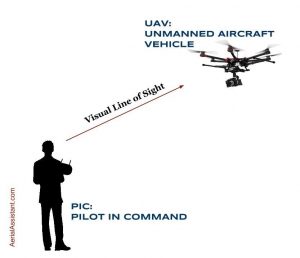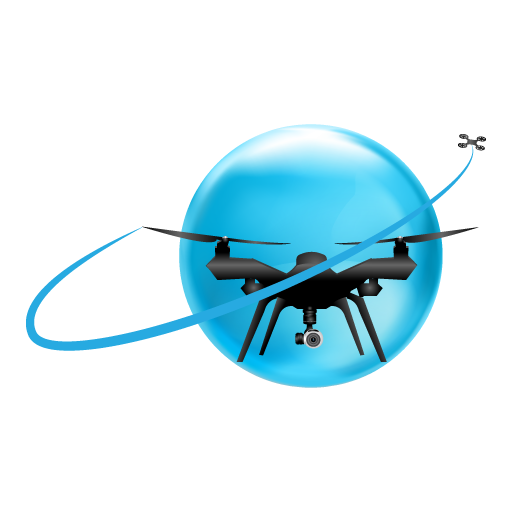On October 5, 2018, Congress passed the FAA reauthorization act that is a comprehensive bill that establishes principles and funding for the FAA for another five decades.
If you are asking what’s the visual line of sight for a drone?
The best answer is, the locational delta between an unmanned aircraft and the Remote Pilot can be a matter of tens of meters or tens of thousands of km and these operating ranges are termed either Visual Line Of Sight (VLOS) or Beyond Visual Line Of Sight (BVLOS) operations.
The new drone rules can’t be immediately implemented therefor ether FAA has advised that amateur pilots adhere to previously published guidelines. One of the items listed below must be recognizable recreational drone pilots.
What does VLOS mean?
Visual Line Of Sight (VLOS) operations; means precisely that, maintaining the unmanned aircraft in visual-line-of-sight whatsoever times.
Included in this bill are provisions that impact unmanned aircraft. A number of these provisions introduce substantial changes to UAS and lay out a strategy to implement new rules and technologies. This summary encircles pages 99-138. This document highlights those parts that are most likely to be of interest to recreational, public and commercial operators of UAS.
Under the new rules, amateur users must enroll each unmanned aircraft separately. Previously, recreational users enrolled themselves, were issued a single ID number that they applied to aircraft. Among the most rapidly developing technologies which will impact drones is UTM, Unmanned Traffic Management. A significant concern with the proliferation of drones is the chance of a midair collision. Drones aren’t detected by radar and air traffic control centers don’t have any method of knowing where drones are compared to manned aircraft.
NASA has been conducting research over the past couple of years to develop an effective UTM system which will mitigate and deconflict unmanned air traffic and manned air traffic. Once implemented, drone operators might be required to broadcast their place. This system could ease drone delivery flights and services beyond a line of sight, which are currently limited.
Overview of H.R. 302 Definitions;
Integration of unmanned aircraft programs into the national airspace system. This section codifies definitions associated with unmanned aircraft systems (UAS). Moreover, this section would update and codify present law about the integration of UAS to the national airspace system (NAS).
This H.R. 302 section directs the FAA to establish a procedure to take risk-based, consensus safety standards for small UAS and authorize the performance of little UAS designed, produced, or altered in accordance with these criteria instead of the more cumbersome certification procedure employed for the approval of additional aircraft.
Public unmanned aircraft programs. This section also directs the FAA to allow the use of people actively tethered UAS (governmental UAS physically connected to a ground station using a tether that supplies the UAS with electricity ) that operate within specific parameters.
Carriage of land (by UAS) for compensation or hire. Carriage of land from small unmanned aircraft systems for hire or compensation. This section requires the FAA to upgrade present regulations authorizing carriage of land from operators of small UAS for compensation or hire within the United States not later than one year after the date of enactment. This section also authorizes the DOT to amend current regulations to establish economic authority for the carriage of land by small UAS for hire or compensation. Finally, this section says that, pending the upgrade of rules required by this section, an individual may seek authority to carry property through a tiny UAS for compensation or hire using existing procedures.
This section creates a framework for the operation of unmanned aircraft including operating requirements, aeronautical knowledge testing, as well as the credentials for community-based organizations that encourage recreational aircraft activities. This section also contains a procedure for FAA to occasionally upgrade operational parameters for recreational aircraft.
The use of unmanned aircraft programs at institutions of higher education. This section enables UAS operated by an institution of higher education for research or educational purposes to fall under the definition of recreational purpose.
The FAA is authorized to establish rules, regulations, and standards, as necessary, to facilitate the safe operation of UAS by institutions of higher education. This section requires the FAA to publish information on authorized little UAS waivers and airspace authorizations and to provide real-time information on program status.
Emergency exemption procedure. This section states the sense of Congress that using UAS by the public and civil operators is becoming an increasingly important tool in response to a catastrophe, disaster or another catastrophe. It further directs the FAA to upgrade and enhance the Special Governmental Interest process to make sure that UAS operators, such as local law enforcement agencies and first responders, can continue to use UAS fast and efficiently in response to a disaster or other crisis. This section also requires the FAA to develop best practices for using UAS by States and localities to respond in emergencies.
This section establishes a civil penalty for operating an unmanned aircraft or unmanned aircraft system that’s armed or equipped with a dangerous weapon.
Section 364. U.S. Counter-UAS system inspection of interagency coordination processes.
This section requires the FAA, in consultation with government agencies authorized to run counter-unmanned aircraft system (C-UAS) systems.
This section requires the FAA to develop a strategy to offer outreach, including a publicly accessible resource site, to State and local governments and supply advice for local law enforcement agencies with respect to the way to identify and respond to security threats posed by UAS and to share information about how UAS may be used to help law enforcement.
Section 368. Public UAS access to special use airspace.
This section directs the DOT to issue guidance for the expedited and timely access to special use airspace for people UAS to help Federal, State, local, or tribal law enforcement organizations in conducting law enforcement, emergency response, or for other actions.
Section 372. Enforcement.
This section directs the FAA to establish a five-year pilot program to use available remote detection or detection technologies for security oversight, including enforcement actions against operators of UAS which aren’t in compliance with applicable Federal aviation legislation, including regulations. This section also directs the FAA to establish and promote a mechanism for the public and Federal, State, and local law enforcement to report suspected unlawful operations of UAS and requires annual reporting to Congress. Eventually, this section adds Chapter 448, as added by this Act, to the civil penalty regime under title 49 of U.S. Code.
Section 376. Plan for a fully operational capacity of unmanned aircraft systems traffic management.
This section directs the FAA, in consultation with other Federal agencies as appropriate, to develop a strategy to allow for the execution of UAS traffic management (UTM) services. Included in this implementation plan, this section directs the FAA to take certain actions, including developing security standards to allow, authorize, or enable the use of UTM services and also to outline the roles and responsibilities of government and industry in establishing UTM services.
Section 379. Governmental and commercial operators.
This section requires the FAA to make available to the general public, through one place on the DOT’s site, information regarding government and business operators authorized to run UAS from the NAS. The information reference above includes where the UAS is enrolled, summary descriptions of operations, and information on UAS which will collect personally identifiable information. This section contains a sunset provision.
Section 381. Unmanned aircraft systems in limited buildings or grounds.
This section amends section 1752 of title 18, U.S. Code, to establish criminal penalties for somebody knowingly and willfully operating a UAS with the intent to intentionally and willfully direct or cause such UAS to enter or operate within or over a limited building or grounds.
Section 382. Prohibition (Interference with public safety operations).
This section amends title 18, U.S. Code, to establish criminal penalties for somebody who operates a UAS and intentionally or recklessly interferes with wildfire suppression, or law enforcement or emergency response effort associated with wildfire suppression.
This section directs the FAA to work with DOD, the Department of Homeland Security (DHS), And other relevant federal departments and agencies to make certain that C-UAS technologies don’t negatively affect or interfere with safe airport operations, navigation, air traffic services, or the safe and effective operation of the NAS. This section also directs the FAA to create a strategy for the certification, permitting, authorizing, or permitting the deployment of C-UAS systems or technologies.
Section 384. Unsafe operation of unmanned aircraft.
This section amends title 18, U.S. Code, to make it a crime to intentionally or recklessly run a UAS in a way that interferes with or disrupts the performance of a manned aircraft or too near a runway.
Contents
